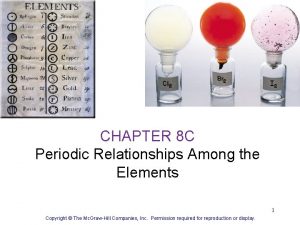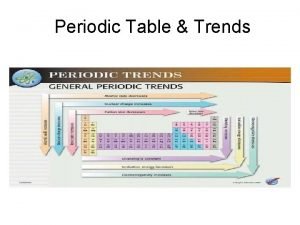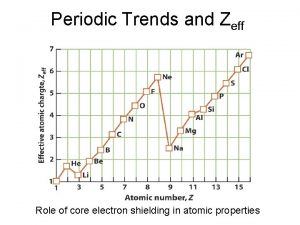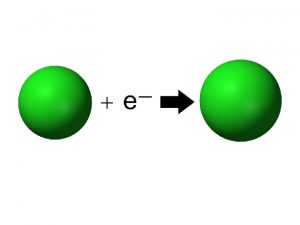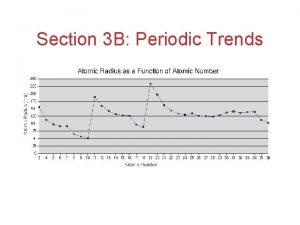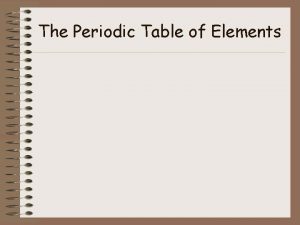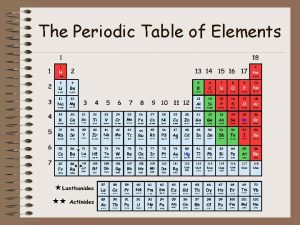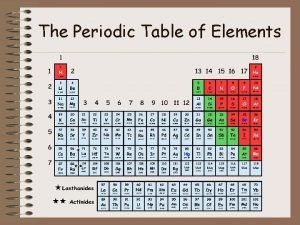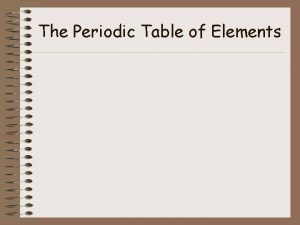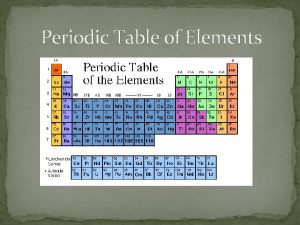Section 3 Periodic Trends among elements in the




















- Slides: 20

Section 3: Periodic Trends among elements in the periodic table include their sizes and their abilities to lose or attract electrons. K What I Know W What I Want to Find Out L What I Learned

• 5(C) Use the Periodic Table to identify and explain periodic trends, including atomic and ionic radii, electronegativity, and ionization energy. • 2(H) Organize, analyze, evaluate, make inferences, and predict trends from data. • 2(I) Communicate valid conclusions supported by the data through methods such as lab reports, labeled drawings, graphs, journals, summaries, oral reports, and technology-based reports. • 3(A) In all fields of science, analyze, evaluate, and critique scientific explanations by using empirical evidence, logical reasoning, and experimental and observational testing, including examining all sides of scientific evidence of those scientific explanations, so as to encourage critical thinking by the student. Copyright © Mc. Graw-Hill Education Periodic Trends

Essential Questions • What are the period and group trends of different properties? • How are period and group trends in atomic radii related to electron configuration? Copyright © Mc. Graw-Hill Education Periodic Trends

Vocabulary Review New • principal energy level • • Copyright © Mc. Graw-Hill Education ionization energy octet rule electronegativity Periodic Trends

Atomic Radius Atomic size is a periodic trend influenced by electron configuration. For metals, atomic radius is half the distance between adjacent nuclei in a crystal of the element. Copyright © Mc. Graw-Hill Education Periodic Trends

Atomic Radius For elements that occur as molecules, the atomic radius is half the distance between nuclei of identical atoms that are chemically bonded together. Copyright © Mc. Graw-Hill Education Periodic Trends

Atomic Radius • Atomic radius generally decreases from left to right, caused by increasing positive charge in the nucleus. Valence electrons are not shielded from the increasing nuclear charge because no additional electrons come between the nucleus and the valence electrons. • Atomic radius generally increases as you move down a group. The outermost orbital size increases down a group, making the atom larger. Copyright © Mc. Graw-Hill Education Periodic Trends

Atomic Radius Copyright © Mc. Graw-Hill Education Periodic Trends

Interpret Trends in Atomic Radii Use with Example Problem 2. Problem Which has the largest atomic radius: carbon (C), fluorine (F), beryllium (Be), or lithium (Li)? Answer without referring to Figure 11 (slide 8). Explain your answer in terms of trends in atomic radii. Response ANALYZE THE PROBLEM You are given four elements. First, determine the groups and periods the elements occupy. Then apply the general trends in atomic radii to determine which has the largest atomic radius. Copyright © Mc. Graw-Hill Education SOLVE FOR THE UNKNOWN • Determine the periods. From the periodic table, all the elements are found to be in period 2. • Apply the trend of decreasing radii across a period. Ordering the elements from left-to-right across the period yields: Li, Be, C, and F. The first element in period 2, lithium, has the largest radius. EVALUATE THE ANSWER The period trend in atomic radii has been correctly applied. Checking radii values in Figure 11 (slide 8) verifies the answer. Periodic Trends

Ionic Radius When atoms lose electrons and form positively charged ions, they always become smaller for two reasons: 1. The loss of a valence electron can leave an empty outer orbital, resulting in a smaller radius. 2. Electrostatic repulsion decreases allowing the electrons to be pulled closer to the nucleus. Copyright © Mc. Graw-Hill Education Periodic Trends

Ionic Radius When atoms gain electrons, they can become larger, because the addition of an electron increases electrostatic repulsion. Copyright © Mc. Graw-Hill Education Periodic Trends

Ionic Radius • The ionic radii of positive ions generally decrease from left to right. • The ionic radii of negative ions generally decrease from left to right, beginning with group 15 or 16. • Both positive and negative ions increase in size moving down a group. Copyright © Mc. Graw-Hill Education Periodic Trends

Ionic Radius Copyright © Mc. Graw-Hill Education Periodic Trends

Ionization Energy • Ionization energy is defined as the energy required to remove an electron from a gaseous atom. • The energy required to remove the first electron is called the first ionization energy. Copyright © Mc. Graw-Hill Education Periodic Trends

Ionization Energy Copyright © Mc. Graw-Hill Education Periodic Trends

Ionization Energy Removing the second electron requires more energy, and is called the second ionization energy. Copyright © Mc. Graw-Hill Education Periodic Trends

Ionization Energy • First ionization energy increases from left to right across a period. • First ionization energy decreases down a group because atomic size increases and less energy is required to remove an electron farther from the nucleus. Copyright © Mc. Graw-Hill Education Periodic Trends

Ionization Energy • The ionization at which the large increase in energy occurs is related to the number of valence electrons. • The octet rule states that atoms tend to gain, lose or share electrons in order to acquire a full set of eight valence electrons. • The octet rule is useful for predicting what types of ions an element is likely to form. Copyright © Mc. Graw-Hill Education Periodic Trends

Electronegativity • The electronegativity of an element indicates its relative ability to attract electrons in a chemical bond. • Electronegativity decreases down a group and increases left to right across a period. Copyright © Mc. Graw-Hill Education Periodic Trends

Review Essential Questions • What are the period and group trends of different properties? • How are period and group trends in atomic radii related to electron configuration? Vocabulary • • ionization energy octet rule electronegativity Copyright © Mc. Graw-Hill Education Periodic Trends
 Periodic table trend
Periodic table trend Boron group number
Boron group number Periodic relationships among the elements
Periodic relationships among the elements Periodic relationships among the elements
Periodic relationships among the elements Periodic relationships among the elements
Periodic relationships among the elements Periodic trends in properties of elements
Periodic trends in properties of elements Atomic size periodic trend
Atomic size periodic trend Mendeleev
Mendeleev Cheat sheet periodic table
Cheat sheet periodic table Ap chemistry chapter 7 atomic structure and periodicity
Ap chemistry chapter 7 atomic structure and periodicity Graphing periodic trends
Graphing periodic trends Oxidation trends periodic table
Oxidation trends periodic table Periodic trends electronegativity
Periodic trends electronegativity Periodic trend zeff
Periodic trend zeff Periodic trends activity worksheet
Periodic trends activity worksheet Periodic trends practice questions
Periodic trends practice questions Periodic trends in reactivity
Periodic trends in reactivity Periodic trends summary
Periodic trends summary Periodic trends practice problems
Periodic trends practice problems Coulomb's law electronegativity
Coulomb's law electronegativity Highest electron affinity
Highest electron affinity



